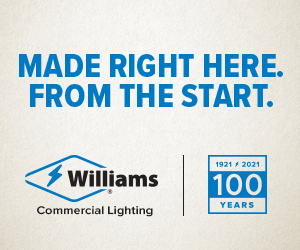UV Disinfection: 9 Decision Points
 By: Al Uszynski
By: Al Uszynski
As the world is one year into its pivot to social distancing, disinfection and mask-wearing, there has been a huge uptick in demand for germicidal ultraviolet lighting solutions.
Like many lighting people, I have learned more about UV light during the pandemic than I knew in all the other years of my lighting career. I do not profess to be an expert in UV lighting technology & applications, but I have conversed with many experts and consider myself to be well-informed.
And also, like many lighting people, I am being asked by “non-lighting” friends and acquaintances about strategies to disinfect spaces using UV light. Here are the decision points and the guidance that I give them:
Healthy Buildings Aren’t a Fad
Fighting Covid-19 is the current need, but future buildings will be held to a higher standard of being healthy buildings. Office workers, hotel guests and other occupants will demand and expect certain building systems that raise the bar on healthy environment expectations
One Sole Disinfection Method is Not Sufficient
UV light can be an effective way of making a space safer, but building owners and facilities people shouldn’t rely solely on one disinfection method. Facilities should consider a layered approach of multiple strategies including HVAC UV disinfection, air filtration, chemical disinfectants, responsible policies and enforcement, staff training, etc. are all methods that could be considered to help make spaces safe.
How “Mission Critical” is the Space?
Strategies to disinfect a hospital’s surgical suite will differ from those utilized in an open building lobby. Understand the needs of the space and how it will be utilized. Is it high traffic? Are there windows that can be opened at times? How does air circulate with the HVAC systems? Is the space wide open – or is it encumbered with furniture, cubicles, partitions, etc.?
Understand the Impact of Time and Distance
When UV light is close to a particle there is more energy and intensity applied to the particle. The longer the exposure time, the greater the total fluence – which maximizes the virus-deactivating impact.
Portable vs. Permanently-Installed Solutions
When feasible, utilizing permanently installed UV disinfection solutions is a preferred method. Portable solutions can be excellent options for a quick and urgent fix, but over time the operational cost and task-discipline to implement portable solutions can become prohibitive and overbearing. And, once a portable solution leaves the space, the space becomes vulnerable to infection again.
Solutions that Require Evacuation
There are many good solutions that deactivate contagious viruses in seconds. This is often achieved by utilizing a UV bandwidth that is harmful to human eyes and skin (i.e. 254nm). Usually sensors, warning labels and other safety features cause these lighting solutions to be generally safe by informed and responsible operators, but there still could be some risk involved to the untrained user, so we generally wouldn’t recommend these solutions for most applications. Healthcare and other specialty applications would be good considerations, though.
Solutions that Don’t Require Evacuation
Far-UV solutions (i.e. 222nm) are generally touted as safe for human occupants while also being effective against viruses. It should be noted that the International UV Association recommends more research before deployment of these solutions in occupied spaces. Due to the UV bandwidth of these solutions, viruses need to be exposed to Far-UV light for longer periods of time in order to be deactivated. The further away the light is, the longer it takes to disinfect.
Air Disinfection vs. Surface Disinfection
When it comes to anti-Covid measures, we should pay more attention to air disinfection than surface disinfection. This is why public health officials stress wearing masks – not gloves. This notion is supported by health experts including an infectious disease expert at UC Davis. Many UV light solutions disinfect both surfaces and air, but won’t be able to reach surfaces that are in the shadows or not in line-of-sight.
Passive Air Disinfection vs. Active Air Disinfection
There are UV-C lighting products that can safely be installed on a wall or ceiling and they will disinfect nearly all of the air particles that passes through them. Air that doesn’t pass through is not disinfected. There are other products that utilize fans and vents to pull air though a UV disinfection chamber. These can be effective solutions, but one should evaluate the amount of time that potentially contaminated air particles are exposed to the UV light. If air is zipping through a UV chamber, even at a close distance, it might not be sterilized unless the exposure time is significant enough to allow for virus deactivation.
The UVC market will continue to grow over the coming years, and we continue to believe that there will not be a one size fit all product for all of the different applications and facility types. The market needs a healthy mix of solutions to better accommodate the growing need, and we expect to see future new product development that can help make spaces safer wherever people gather.
Don’t miss the next big lighting story…Click here to subscribe to the inside.lighting InfoLetter |










































